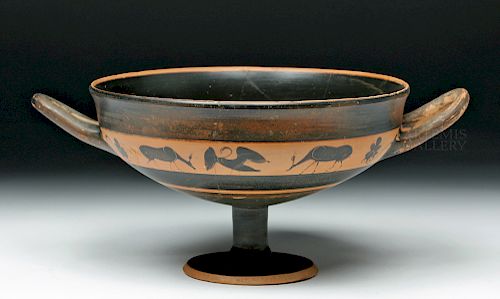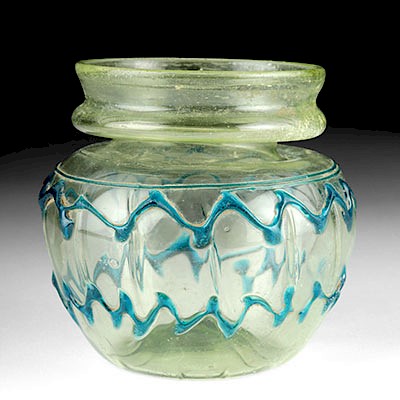Greek Attic Black-Figure Lip Cup - Deer & Swans
Lot 15
About Seller
Artemis Fine Arts
686 S Taylor Ave, Ste 106
Louisville, CO 80027
United States
Selling antiquities, ancient and ethnographic art online since 1993, Artemis Gallery specializes in Classical Antiquities (Egyptian, Greek, Roman, Near Eastern), Asian, Pre-Columbian, African / Tribal / Oceanographic art. Our extensive inventory includes pottery, stone, metal, wood, glass and textil...Read more
Estimate:
$8,500 - $12,750
Absentee vs Live bid
Two ways to bid:
- Leave a max absentee bid and the platform will bid on your behalf up to your maximum bid during the live auction.
- Bid live during the auction and your bids will be submitted real-time to the auctioneer.
Bid Increments
| Price | Bid Increment |
|---|---|
| $0 | $25 |
| $300 | $50 |
| $1,000 | $100 |
| $2,000 | $250 |
| $5,000 | $500 |
| $10,000 | $1,000 |
| $20,000 | $2,500 |
| $50,000 | $5,000 |
| $100,000 | $10,000 |
| $200,000 | $20,000 |
About Auction
By Artemis Fine Arts
Aug 16, 2018
Set Reminder
2018-08-16 10:00:00
2018-08-16 10:00:00
America/New_York
Bidsquare
Bidsquare : Clearance Sale - Ancient / Ethnographic Art
https://www.bidsquare.com/auctions/artemis-gallery/clearance-sale---ancient-ethnographic-art-3368
These lots are going, going, gone... plus a nice selection of lots brand-new to auction! Artemis Fine Arts info@artemisfinearts.com
These lots are going, going, gone... plus a nice selection of lots brand-new to auction! Artemis Fine Arts info@artemisfinearts.com
- Lot Description
**Originally Listed At $6000**
Ancient Greece, Athens, ca. 540 BCE. A beautiful Attic lip cup - a type of Little Master Cup or kylix - created during the mid 6th century BCE that resembles a Gordion cup, only its lip is more defined from the rest of the body, standing on a hollow conical pedestal foot with a broad base. In this example the lip is undecorated; however, just beneath the lip and on the exterior wall is a lovely surprise, a register featuring a skillfully delineated swan flanked by a pair of deer - this scene on both sides, with tendrilled palmettes to either side of the upraised loop handles. A concentric circle adorns the tondo, as is customary for Attic-ware. Lip cups were somewhat difficult to produce, and the pronounced ridge underneath the rim of lip cups would have prevented spillage. Size: 10.875" in diameter x 4.875" H (27.6 cm x 12.4 cm)
This piece presents strong Attic black-figure painting - a painting technique from the Archaic period. The artist first painted with slipware and then carefully scratched into it with a type of needle in order to incise the lines, thus creating delightful figures and patterns. In this case, the artist has depicted deer, an animal sacred to Artemis, the goddess of the wilderness, and swans which played a complex role in Greek mythology. The swan was the attribute of Aphrodite and Apollo, said to sing a song of unearthly beauty as it dies, and as the form assumed by Zeus to ravish Leda, mother of Helen of Troy. Both deer and swans were popular motifs used in a variety of tablewares from this period. Judging from this example, one can see why.
Provenance: ex private Manhattan, New York, USA collection; acquired from Galleria Serodine, Ascona, 1984 (Schweizerische Kunst-und AntiquitA few tiny nicks to rim of base. Repaired from about a half dozen pieces with areas of restoration near the break lines. Surface wear with some areas of pigment loss as shown. Nice areas of iridescence.Condition
- Shipping Info
-
All shipping is handled in-house for your convenience. Your invoice from Artemis Gallery will include shipping calculation instructions. If in doubt, please inquire BEFORE bidding for estimated shipping costs for individual items.
-
- Buyer's Premium



 EUR
EUR CAD
CAD AUD
AUD GBP
GBP MXN
MXN HKD
HKD CNY
CNY MYR
MYR SEK
SEK SGD
SGD CHF
CHF THB
THB

















